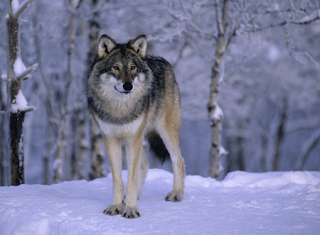
Trends often emerge in biological research, with several papers on a similar topic being released over short periods of time. This seems to be the case for poaching, which I wrote about last week. That post covered the development of new survey techniques that more accurately estimate poaching rates among groups of potential hunters—in that case, South African farmers. Just a couple days later, a new study was published in which collaborators from the Swedish University of Agricultural Sciences, Hedmark University College, the Norwegian Institute for Nature Research, and Colorado State University reported on their use of mathematical modeling to explore the concept of “cryptic poaching” and measure its potential impacts on conservation efforts among Scandinavian wolves (Canis lupus).
From 1999-2009, the authors radio-tracked 104 wolves—approximately 10-15% of the total population—in order to quantify breeding attempts and population growth, and later determine the causes of the wolves’ deaths. Of the 26 verified mortalities during the study, 5 were known to be caused by poaching (a necropsy revealed a deliberately caused death outside of a legal hunt, or someone was later convicted of the death in question), while another 18 were thought to result from “cryptic poaching.” This category comprised all sudden, unexpected losses of radio transmitter signal, where individuals could not be located with aerial searches, snow-tracking efforts, or DNA sampling of scat, and/or where circumstances strongly indicated that poaching was likely (for instance, there were police reports documenting an attempted poaching attempt).
In addition to collecting empirical data, the researchers also used mathematical modeling to estimate probable mortality rates associated with non-poaching, verified poaching, and suspected poaching, so that they could compare these with the rates actually observed in the wild.
Over the course of the 10-year study, poaching accounted for 51% of total mortality; 69% of these deaths could be attributed to cryptic poaching. Rates of cryptic poaching observed in the field were very similar to those calculated with the mathematical model, suggesting that this possible source of death was, in fact, very probable.
While the original study population included only 74 individuals, it eventually grew to 263. Although this sounds like a success story for this endangered species, growth would have been almost 4 times this (yielding 990 individuals) had there been no poaching. Even if only cryptic poaching had been absent, the population could have grown to 676 wolves.
The authors of the study are quick to point out that they cannot prove that what they have measured—in the field and with computer models—is actual poaching. However, their data clearly show that there is an additional source of wolf loss outside of natural death and known poaching. Since the wolf population on the Scandinavian population is very remote from the Finnish/Russian population and migration between these two groups is known to be extremely rare, it seems that cryptic poaching is the most likely cause of wolf loss in this area.
This has kept the annual growth rate to a mere 13.5%, despite the fact that it could theoretically be as high as 29.5%. Because of these slow growth rates, officials refuse to distribute permits for legally killing problem individuals. This, in turn, has increased wolf-human conflicts, meaning that, in effect, the poachers are undermining their own cause. Of course, they are also undermining the wolves’ cause, in more ways than one: The lack of genetic variation among the slowly-growing population has shrunk the gene pool to a dangerously small size, further constraining the animals’ ability to rebound from centuries of persecution.
Scandinavian wolves are not the only animals thought to suffer from cryptic poaching, rates of which have been estimated at anywhere from 32-74% among timber wolves, lynx (Lynx lynx), wolverines (Gulo gulo), and Amur tigers (Panthera tigris). In populations of these and other affected species, cryptic poaching can have a huge influence on conservation work. Thus, the authors of the current study suggest that researchers need to make an effort to better understand the role of this factor, and the uncertainty it causes in datasets; to this end, they advocate the development of more and improved methods of calculating this complex and influential variable.
---
Liberg, O., Chapron, G., Wabakke, P., Pedersen, H.C., Hobbs, N.T., and Sand, H. 2011. Shoot, shovel, and shut up: cryptic poaching slows restoration of a large carnivore in Europe. Proceedings of the Royal Society B, online advance publication.
Thanks to http://environment.no/Topics/Biological-diversity/Large-carnivores/Wolf/ for providing the images used in this post.


No comments:
Post a Comment